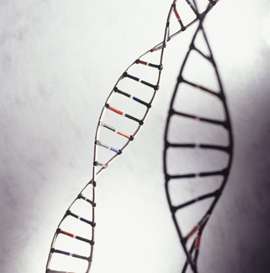Credit: NIH
Evolution is thought to proceed through the gradual accumulation of independent mutations in each new generation. In a study published online today in Genome Research, researchers analyzing hominid genomes have discovered thousands of clustered mutations likely resulting from the coordinated activity of APOBEC enzymes, leading to accelerated changes in DNA.
Mutations occur through a variety of mechanisms, including mutagenic agents such as ultraviolet radiation, and error-prone cellular processes such as DNA replication and repair. In cancer, it was recently recognized that mutations could occur as the result of human APOBEC enzymes, which deaminate cytosines and lead to many clustered base substitutions in DNA. Interestingly, the APOBEC family, and in particular APOBEC3, have dramatically expanded in copy number in primates. The expansion is thought to be in response to the emergence of primate-specific viruses, which APOBECs target for inactivation.
Interested in whether the same mutational process that occurs in cancer could be occurring over evolutionary timescales, researchers from the lab of Erez Levanon, at Bar-Ilan University and from the lab of Alon Keinan at Cornell University examined genome sequences from modern and archaic humans, as well as other great apes, to detect signatures of ABOPEC-induced mutations. They looked for clusters of mutations that occurred in a coordinated manner in humans but not in other species and detected tens of thousands of them. Clustered mutations originating from cytosine bases were the most abundant and were enriched in the viral sequence motif targeted by APOBEC3G, suggesting they may have resulted from APOBEC-induced cytosine deamination.
Furthermore, when examining the locations of the clustered mutations, the researchers found they were enriched in transcriptionally active and regulatory regions of the human genome. Over a third of mutations overlapping coding regions led to amino acid changes, and in several cases an entire mutation cluster overlapped, resulting in up to five amino acid substitutions in a single exon.
"Our results are at odds with assumptions of mutational models that are at the basis of most genetic analyses, including in medical genetics, evolutionary genetics, and population genetics," co-corresponding author Keinan said. "It is tempting to suggest that some of the features that make us human are the result of this evolution 'fast track' option," said co-corresponding author Levanon.
In contrast, the mouse genome, which lacks APOBEC3G, did not have signatures of clustered mutations, suggesting that APOBEC-induced mutations have contributed specifically in hominid genomes.
"This study opens up new opportunities and avenues of research. For instance, whether the activity of the APOBEC3G enzyme is persistent or confined to discrete 'mutational eruptions,' potentially due to exposure to viral agents," said co-first authors, Yishay Pinto and Orshay Gabay. "Moreover, it is already known that APOBEC genes are polymorphic between human populations, therefore investigation of population-specific evolutionary effects would be of great interest."
More information: Pinto Y, Gabay O, Arbiza L, Sams AJ, Keinan A, Levanon EY. 2016. Clustered mutations in hominid genome evolution are consistent with APOBEC3G enzymatic activity. Genome Res doi: 10.1101/gr.199240.115
Journal information: Genome Research
Provided by Cold Spring Harbor Laboratory






















